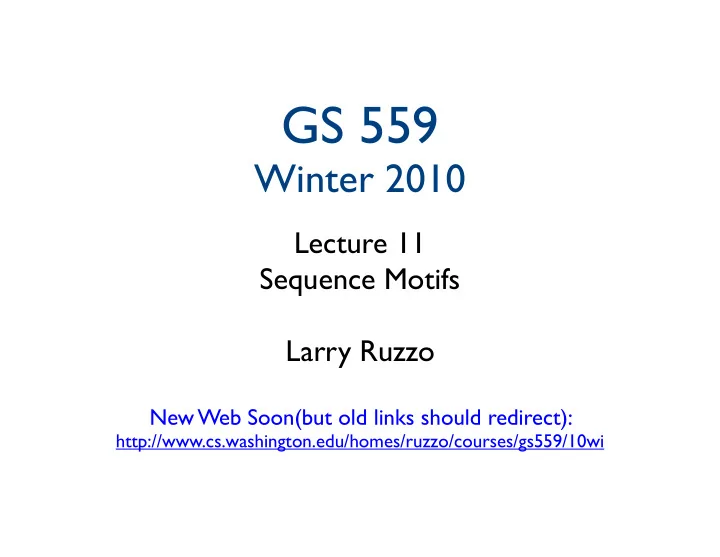

GS 559 Winter 2010 Lecture 11 Sequence Motifs Larry Ruzzo New Web Soon(but old links should redirect): http://www.cs.washington.edu/homes/ruzzo/courses/gs559/10wi
Who Am I? Prof. Computer Science & Engineering Adjunct Prof., Genome Sciences Joint Member, FHCRC Main research interest: noncoding RNA http://www.cs.washington.edu/homes/ruzzo ruzzo@uw.edu 554 CSE, 543-6298 Office Hours: Mondays 2:30-3:20, or by appt
Outline Bioinformatics: Sequence Motifs Sequence Logos Weight Matrix Models (WMMs) aka Position Specific Scoring Matrices (PSSMs, possums) aka 0th order Markov models Construction, statistics, uses Programming: Regular expressions
Motifs Motif : “a recurring salient thematic element”
Motifs Motif : “a recurring salient thematic element”
MyoD http://www.rcsb.org/pdb/explore/jmol.do?structureId=1MDY&bionumber=1
Sea Urchin - Endo16
Sequence Motifs Motif : “a recurring salient thematic element” E.g., structural motifs in proteins (zinc finger, H-T -H, leucine zipper, ... are various DNA binding motifs) E.g., the DNA sequence motifs to which these proteins bind - e.g. , one leucine zipper dimer might bind (with varying affinities) to 10s or 100s or 1000s of similar sequences
E. coli Promoters “TATA Box” ~ 10bp upstream of transcription start How to define it? TACGAT Consensus is TATAAT TAAAAT TATACT BUT all differ from it GATAAT Allow k mismatches? TATGAT Equally weighted? TATGTT Wildcards like R,Y? ({A,G}, {C,T}, resp.)
E. coli Promoters “TATA Box” - consensus TATAAT ~10bp upstream of transcription start Not exact: of 168 studied (mid 80’s) – nearly all had 2/3 of TAxyzT – 80-90% had all 3 – 50% agreed in each of x,y,z – no perfect match (Other common features at -35, etc.)
TATA Box Frequencies pos 1 2 3 4 5 6 base A 2 94 26 59 50 1 C 9 2 14 13 20 3 G 10 1 16 15 13 0 T 79 3 44 13 17 96 Sequence Logo http://weblogo. berkeley.edu
Frequencies Frequency ⇒ Scores: pos 1 2 3 4 5 6 base log 2 (freq/background) A 2 94 26 59 50 1 C 9 2 14 13 20 3 G 10 1 16 15 13 0 T 79 3 44 13 17 96 Scores pos 1 2 3 4 5 6 base A -36 19 1 12 10 -46 (For convenience, scores multiplied by C -15 -36 -8 -9 -3 -31 10, then rounded) G -13 -46 -6 -7 -9 -46 T 17 -31 8 -9 -6 19
Scanning for TATA A -36 19 1 12 10 -46 C -15 -36 -8 -9 -3 -31 = -90 G -13 -46 -6 -7 -9 -46 T 17 -31 8 -9 -6 19 A C T A T A A T C G A -36 19 1 12 10 -46 C -15 -36 -8 -9 -3 -31 = 85 G -13 -46 -6 -7 -9 -46 T 17 -31 8 -9 -6 19 A C T A T A A T C G A -36 19 1 12 10 -46 C -15 -36 -8 -9 -3 -31 = -91 G -13 -46 -6 -7 -9 -46 T 17 -31 8 -9 -6 19 A C T A T A A T C G Stormo, Ann. Rev. Biophys. Biophys Chem, 17, 1988, 241-263
Scanning for TATA 100 85 66 50 50 23 Score 0 -50 -100 -90 -91 -150 A C T A T A A T C G A T C G A T G C T A G C A T G C G G A T A T G A T
TATA Scan at 2 genes LacI 50 Score -50 -150 LacZ 50 Score -50 -150
Score Distribution (Simulated) 3500 3000 2500 2000 1500 1000 500 0 -150 -130 -110 -90 -70 -50 -30 -10 10 30 50 70 90
Weight Matrices: Thermodynamics Experiments show ~80% correlation of (log likelihood) weight matrix scores to measured binding energy of RNA polymerase to variations on TATAAT consensus [Stormo & Fields]
What’s best WMM? Given, say, 168 sequences s 1 , s 2 , ..., s k of length 6, assumed to be generated at random according to a WMM defined by 6 x (4-1) parameters θ , what’s the best θ ? Answer: count frequencies per position. More justification next time, but if you saw 900 Heads in1000 coin flips, you’d perhaps estimate P(Heads) = 900/1000
Pseudocounts Freq/count of 0 ⇒ - ∞ score; a problem? Certain that a given residue never occurs in a given position? Then - ∞ just right. Else, it may be a small-sample artifact Typical fix: add a pseudocount to each observed count—small constant (e.g., .5, 1) Sounds ad hoc ; there is a Bayesian justification Influence fades with more data
How-to Questions Given aligned motif instances, build model? Frequency counts (above, maybe w/ pseudocounts) Given a model, find (probable) instances Scanning, as above Given unaligned strings thought to contain a motif, find it? (e.g., upstream regions of co- expressed genes) Hard ... maybe another lecture.
WMM Summary Weight Matrix Model (aka Position Specific Scoring Matrix, PSSM, “possum”, 0th order Markov models) Simple statistical model assuming independence between adjacent positions To build: align, count (+ pseudocount) letter frequency per position, log likelihood ratio to background To scan: add per position scores, compare to threshold, slide Databases & tools: Transfac, Jaspar, MEME/MAST, ...
Recommend
More recommend